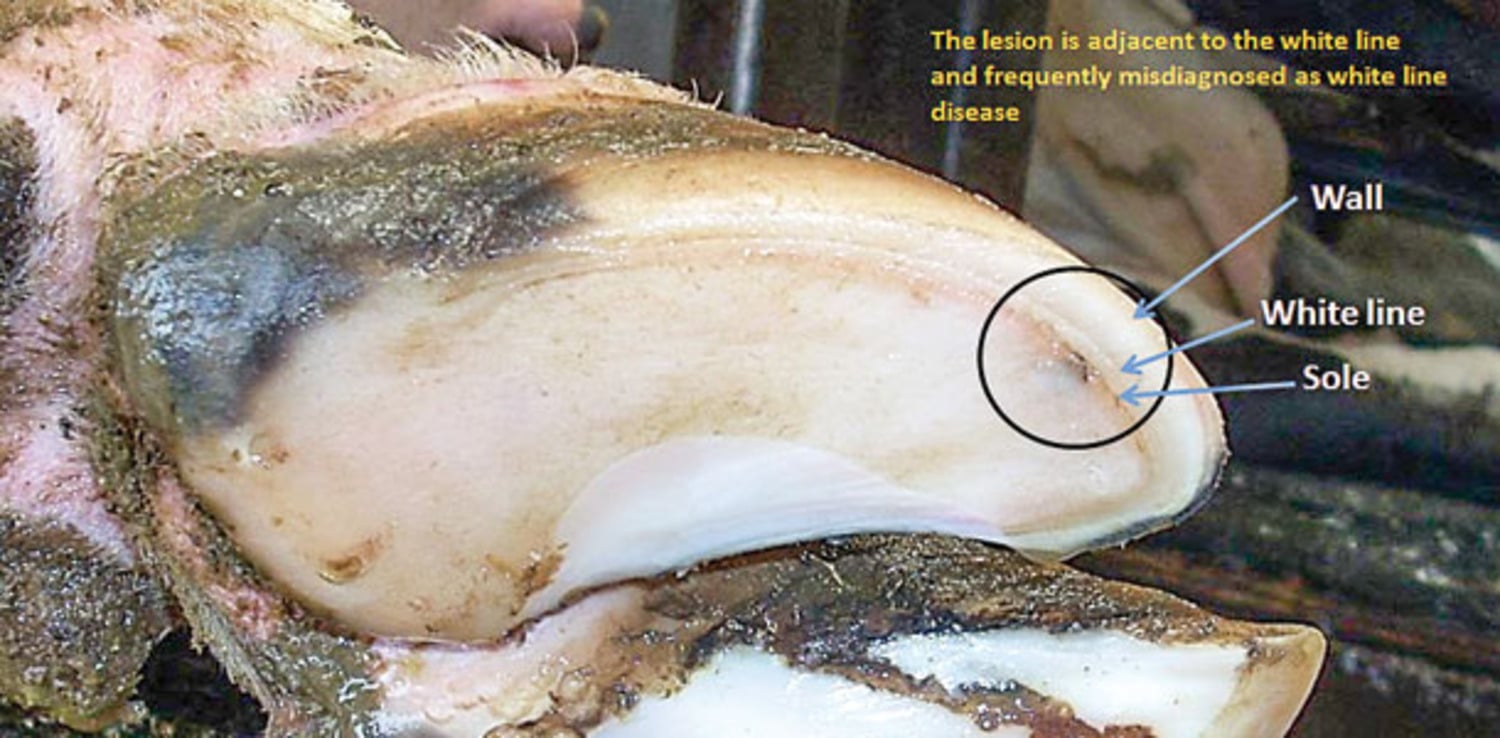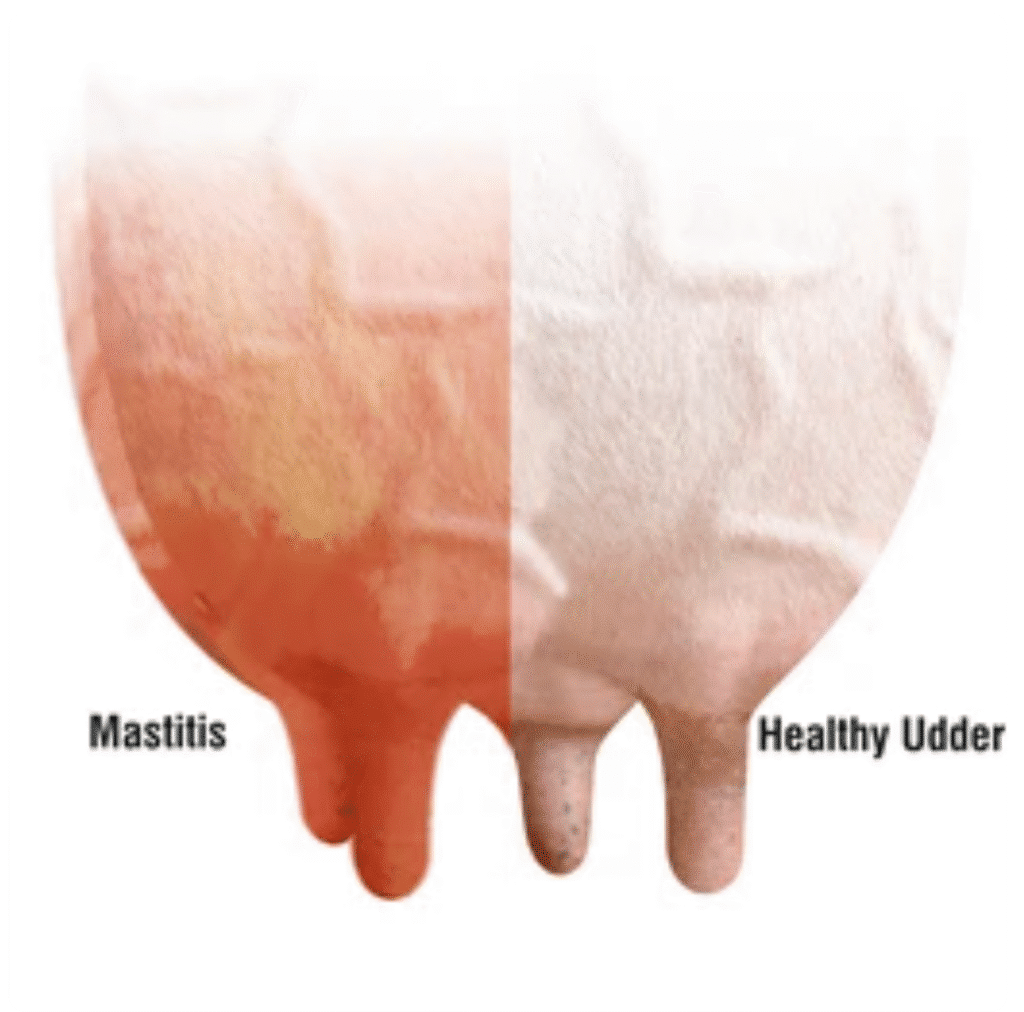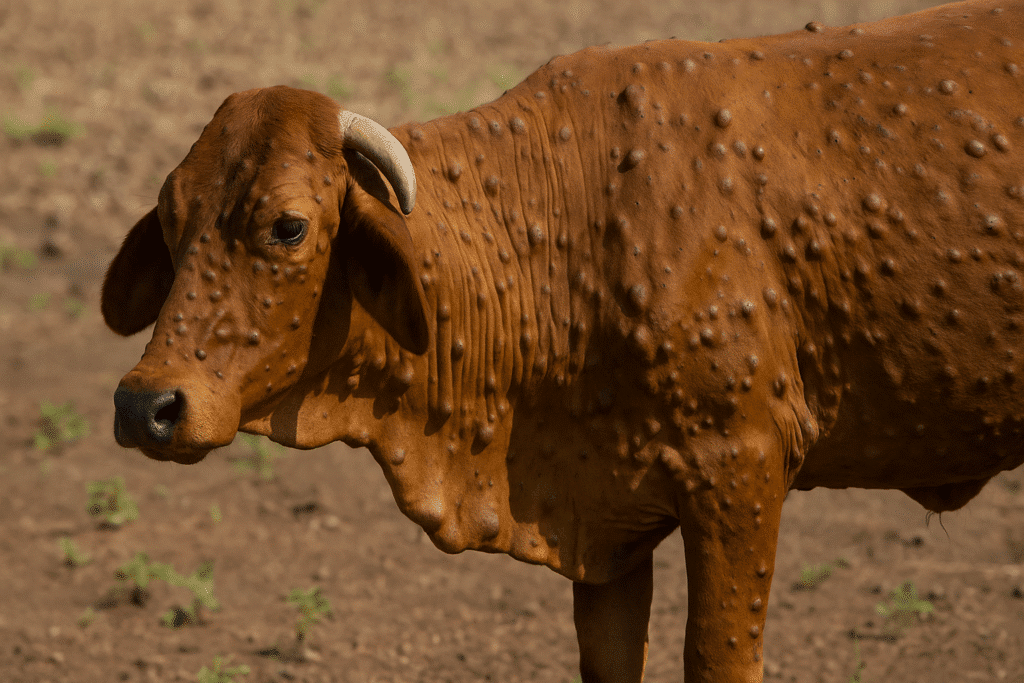White line disease happens when the hard outer part of the hoof starts to come apart from the bottom part. This usually happens in the white line area, which is a weaker spot on the hoof. Walking on hard or slippery floors can put stress on the hoof and make it worse. When the white line gets damaged, a small gap forms. Dirt and germs can get inside through this gap, which can cause pain and make the animal limp. White line disease cattle suffer significant mobility and productivity issues if the condition is left untreated.
White line is a very common disease in dairy cattle, affecting six cows per 100 per year in the world. If the animal is affected by white line, on average, a single case costs around £193($262), resulting in an estimated annual cost of over £1,000 per 100 cows. However, in herds where the condition is more prevalent—exceeding 30 cases per 100 cows each year—the financial impact can be much greater, reaching approximately £5,800 per 100 cows annually. This shows why it’s important to catch the disease early, treat it properly, and take steps to prevent it. Doing so can help lower how often it happens and reduce treatment costs.
White line disease cattle symptoms
Cattle with white line disease usually show clear signs, especially limping and damage to the hoof. The animal may walk unevenly or avoid putting weight on the sore foot. Pain and lameness are the main signs that something is wrong. Visually, affected hooves often show separation along the white line—the junction between the wall horn and the sole horn. Sometimes accompanied by bleeding or the presence of pus, especially if an abscess has developed. The area may appear bruised or darker in color, and in more severe cases, the separation can extend upward toward the coronary band.
Behaviorally, cattle may limp, favor the affected leg, or exhibit a noticeable change in
Hoof in white line
- White line separation: Clear separation between hoof wall and sole.
- Bleeding or pus: Indicating abscess or advanced infection.
- Bruising/darkening: Along the white line, often near the outer hind claw.
- Hoof wall separation: May extend up toward the coronary band.
- Abscess formation : Severe cases can involve swelling and pus accumulation.
- Lameness : Limping or favoring one leg.
- Pain sensitivity : Especially evident when pressure is applied.
- Altered gait/posture : To avoid weight on the affected area.
- Reluctance to bear weight : On the affected foot.
- Depression or lethargy : Especially in chronic or untreated cases.
Causes of White Line Disease in Cattle
White Line Disease (WLD) in cattle is caused by damage to the white line, a soft, light-colored area in the hoof that joins the hard wall horn to the sole horn. This area is made by laminae, and it’s a weak point in the hoof.
When the laminae are disturbed by bruising, pressure, or injury, the white line becomes weaker and can split or crack. This makes it easy for stones, dirt, or bacteria like(Fusobacterium necrophorum, Arcanobacterium pyogenes) to get inside, which can lead to pain, infection, and lameness. WLD mostly occurs due to factors like physical pressure, poor flooring, wet conditions, thin soles and poor nutrition.
1:Pressure, Twisting, and Sharp Surfaces
The white line is under constant stress when cows walk, turn, or push on hard ground. These movements cause twisting forces that weaken or bruise the hoof. Rough floors and uneven surfaces make it worse. Small stones or grit can enter cracks and carry bacteria deep inside, leading to abscesses and infection. Most cases affect the outer claw of the back feet, where pressure is greatest.
2:Wet Conditions
When hooves stay wet for too long—like in muddy or dirty barns—the horn becomes soft and easier to damage. A wet horn doesn’t protect well and allows dirt and bacteria to enter the hoof more easily.
3:Thin Soles
Over-trimming or excessive hoof wear can make the sole too thin. A thin sole gives less protection and shifts more pressure onto the white line, which increases the chances of it breaking apart.
4:Poor Horn Quality (Nutrition Issues)
A healthy hoof depends on good nutrition. If a cow isn’t getting enough important nutrients like biotin and zinc, the hoof becomes weak and cracks more easily, especially at the white line where the horn is already softer.
How It Gets Worse Over Time
The horn of the white line is made at the top of the hoof and moves downward about 5mm each month. Weak spots between the folds of the laminae often appear as dark lines or tracks where dirt enters. These cracks can go deeper over time, reaching the sensitive inner parts of the hoof. When bacteria reach this area and can’t drain out, an infection may build up and cause swelling, pain, and serious lameness.
Treatment of White Line Disease in Cattle
White Line Disease (WLD) in cattle can be painful and, if left untreated, can lead to serious hoof damage and long-term lameness. The main goal of treatment is to remove damaged horn, stop infection, reduce pressure on the injured hoof, and help the cow walk comfortably again. Below is a complete guide on how to treat this condition effectively.
1. Hoof Cleaning and Functional Trimming
The first and most important step is to trim the hoof and remove any loose, damaged horn in the white line area. This helps expose the lesion and lets air in, which discourages harmful bacteria from growing.
- Use a sharp hoof knife or rotary tool.
- Remove only the damaged horn—avoid cutting too deep or injuring healthy tissues.
- Open any cracks or crevices that may trap manure or stones.
- For deep lesions, trimming allows drainage of pus and relieves pressure.
Tip: Do not over-trim. The goal is to remove weak horn and expose clean, healthy tissue underneath.
2. Infection Control and Topical Treatment
After trimming, disinfect the area to prevent or treat infection. Some safe and effective products include:
| Topical Treatment | Purpose | How to Apply |
| Copper sulfate powder | kills bacteria, dries the lesion | Pack in cotton or gauze inside the cavity |
| 7% Iodine solution | General antiseptic | Spray or dab on trimmed area |
| Oxytetracycline spray | Fights bacterial infection | Spray directly on infected or smelly wounds |
| Hoof healing gels | harden and heal horn | Apply before covering with a bandage |
| Chlorhexidine or Hydrogen Peroxide (diluted) | Flushes debris & infection | Flush before antibiotic use (optional) |
3. Pain Relief Through Weight Redistribution
To reduce pain and help healing, apply a hoof block to the opposite (healthy) claw. This removes pressure from the damaged claw.
- Helps the cow walk better
- Speeds up healing
- Usually placed on the inner claw of the affected hind foot (since outer claws are more commonly affected)
4. Systemic Medications (If Needed)
If there is deep infection, pus, or swelling, systemic medications may be required in addition to hoof trimming and cleaning. Below is a table of widely used, vet-approved medications:
| Generic Name | Purpose | Common Brand Examples (Global/US Market) | Route & Use |
| Oxytetracycline (LA) | Long-acting broad-spectrum antibiotic | LA-200, Bio-Mycin 200, Noromycin 300 LA | IM injection, typically every 72 hours |
| Flunixin Meglumine | NSAID – pain and inflammation relief | Banamine®, Flunixamine®, Vetameg™ | IV or IM, once daily |
| Meloxicam | Long-lasting anti-inflammatory | Metacam®, Meloxidyl®, Loxicom® | Oral bolus or subcutaneous injection |
Always follow veterinarian dosage guidance and withdrawal periods for milk or meat production.
Note: These medicines help the animal heal, especially if there’s an infection. But they can’t replace proper hoof trimming and cleaning of the infected area.
5. Follow-Up and Monitoring
- After treatment: Check the hoof again in 7 to 10 days to see how the healing is going.
- If it still looks dirty or sore, gently clean it and treat it again.
- Look at the hoof block — if the cow is walking better, you can adjust it or take it off.
- Full healing usually takes around 2 to 6 weeks, depending on how serious the injury was.
Deeper or Complicated Infections
In more serious cases:
- If pus or swelling is present above the hoof or near the coronary band, the lesion may need to be trimmed again for better drainage.
- If abscesses are deep or if the infection tracks up the wall, a veterinarian should be called.
- Sometimes, the wall must be partially removed under local anesthesia to clear infection from the deeper horn layers.
Best Practices for Recovery
- Keep hoof areas dry, clean, and well-bedded.
- Feed a balanced diet with biotin, zinc, and copper for strong horn growth.
- Avoid over-conditioning; excess body weight adds more strain to hooves.
- Record all cases with date, cow number, foot affected, and treatment.
- Ensure trained foot trimmers or vets handle moderate to severe cases.
Prevention of White Line Disease in Cattle
White Line Disease (WLD) is one of the leading causes of lameness in dairy cattle. It begins when the soft area between the wall and sole of the hoof becomes damaged or infected. Preventing this painful condition requires smart management of housing, flooring, cow flow, nutrition, and regular hoof care. Below are practical and proven ways to reduce the risk of WLD in your herd.
1. Improve Cow Comfort and Minimize Standing Time
Cows that stand for long hours on hard concrete are more likely to develop hoof problems. Try to reduce the time cows spend standing in the collecting yard or waiting areas, especially before milking. Ideally, cows should be lying down at least 12 hours a day to reduce stress on their hooves.
- Ensure clean, soft bedding and good cubicle design.
- Aim for more cubicles than cows (at least 5% extra) to avoid overcrowding.
- Keep cows away from feed and cubicles for no more than 1 hour per milking.
2. Make Movement Safe and Stress-Free
Rough movements, pushing, and tight turns increase the pressure on hooves, especially on the white line. Improving cow flow is essential.
- Widen walkways to allow cows to walk comfortably without turning sharply.
- Avoid shouting or rushing cows—let them move at their own pace.
- Use non-slip rubber matting in high-traffic areas (like parlour exits or tight corners).
- Modify barn design by adding cross passages or opening blind alleys to reduce crowding and stress.
3. Maintain Good Cow Tracks (for Grazing Herds)
For herds that graze, worn or stony tracks can lead to hoof injuries. Pay special attention to walking paths outside the barn.
- Cow tracks should be stone-free, well-drained, and used only by cattle (no heavy machines).
- Consider using astroturf or soft matting to cover rough areas.
- Watch out for risky spots near gates and water troughs, where cows often gather and turn.
4. Support Hoof Health with Proper Nutrition
A cow’s diet plays a big role in hoof strength. Research shows that giving 20 mg of biotin per cow per day can reduce white line disease cases by up to 50%. However, results take time, usually 4–6 months, since a healthy horn needs time to grow.
- Ensure cows maintain a steady body condition during early lactation to protect hoof cushions.
- Include biotin, zinc, and copper in the feed to support hoof quality and reduce bruising.
- Avoid sudden feed changes or diets that increase the risk of subclinical rumen acidosis (SARA), which may indirectly weaken hoof health.
5. Perform Regular and Strategic Hoof Trimming
Preventative hoof trimming keeps hooves balanced and helps spot early signs of WLD before it worsens.
- Trim hooves at least twice a year or as recommended by a professional trimmer.
- Train staff or hire accredited hoof trimmers who follow safe trimming practices.
- Never delay trimming in cows that show early signs of discomfort or uneven walking.
Conclusion: White Line Disease in Cattle
White line disease in cattle is a multifactorial hoof disorder rooted in structural weakness, mechanical stress, and environmental challenges. White line disease isn’t contagious, but if not managed, it can badly affect how the herd moves, feels, and performs. Spotting it early through regular hoof checks, along with proper trimming, treatment, and care, is key to managing it well. Long-term control depends on proactive prevention strategies—balanced nutrition, clean housing conditions, and proper hoof maintenance. Good hoof health is closely linked to how well an animal performs, so it’s important to treat white line disease in cows with proper and regular care. With early spotting and the right treatment, this problem can be managed and greatly reduced in both dairy and beef herds.
FAQs related to White line disease in cattle
How to treat white line disease
White line disease is treated by trimming away the damaged hoof area, removing debris, and keeping the hoof clean and dry. In severe cases, a hoof block and antibiotics may be needed.
Is white line disease painful
Yes, white line disease is painful, especially when debris enters the separation and causes infection. It often leads to lameness and discomfort while walking.
What causes white line disease
White line disease is caused by stress or trauma to the hoof, especially on hard or slippery surfaces. This weakens the white line area, allowing bacteria and debris to enter and cause separation.
What is white line disease
White line disease is a hoof condition where the wall and sole separate at the white line, creating a gap that allows dirt and bacteria to enter. It often leads to lameness and infection if untreated.
Can white line disease be cured
Yes, white line disease can be cured with early detection, proper hoof trimming, cleaning, and care. Severe cases may require more intensive treatment but usually respond well with consistent management.




